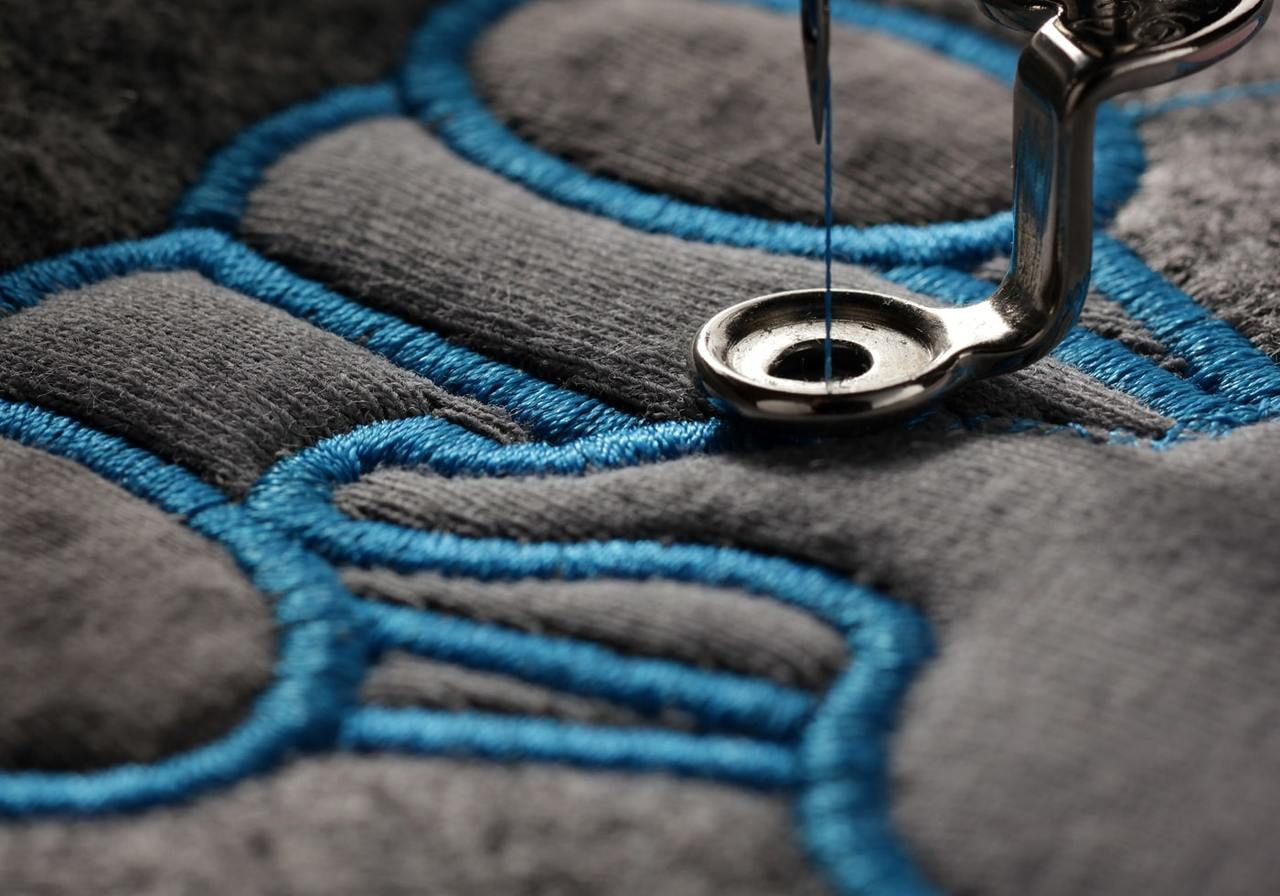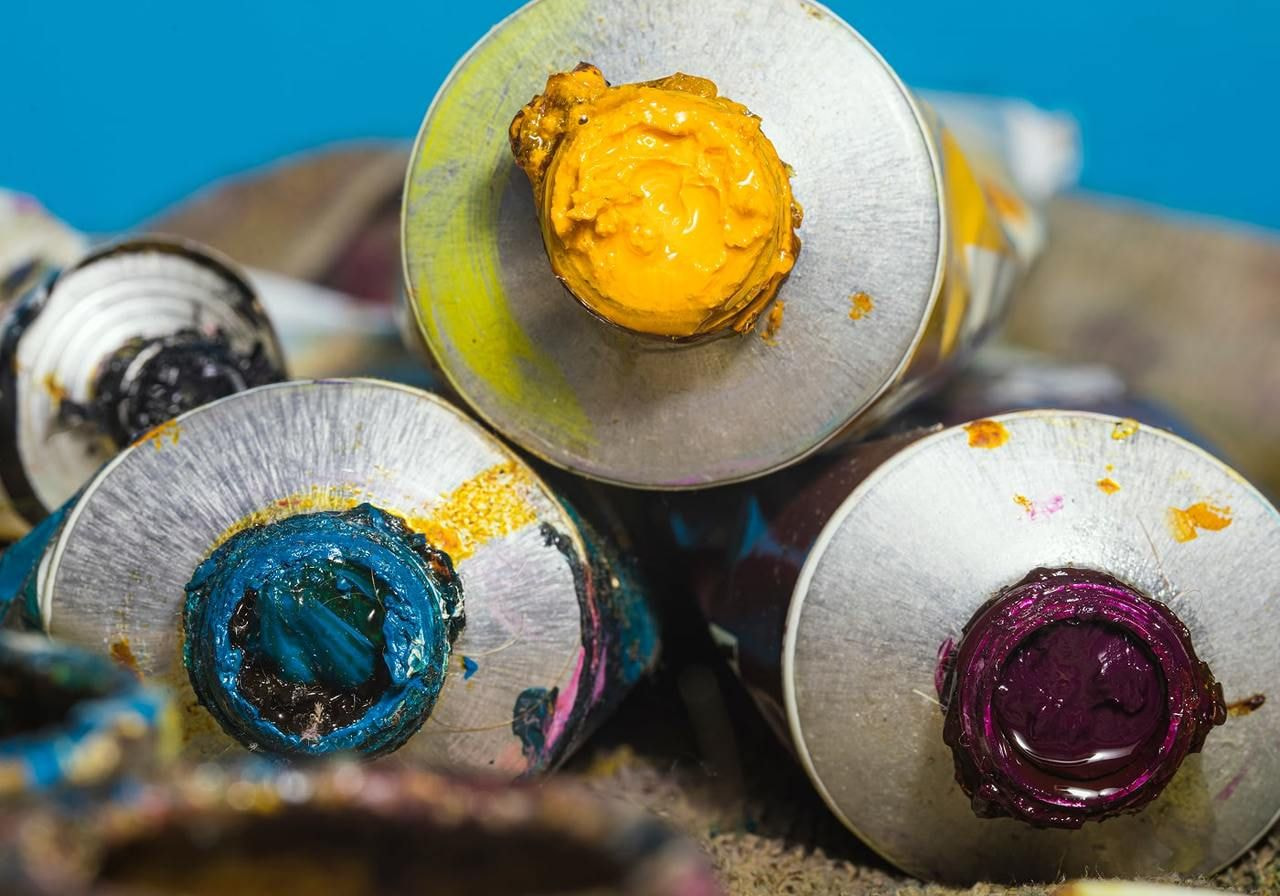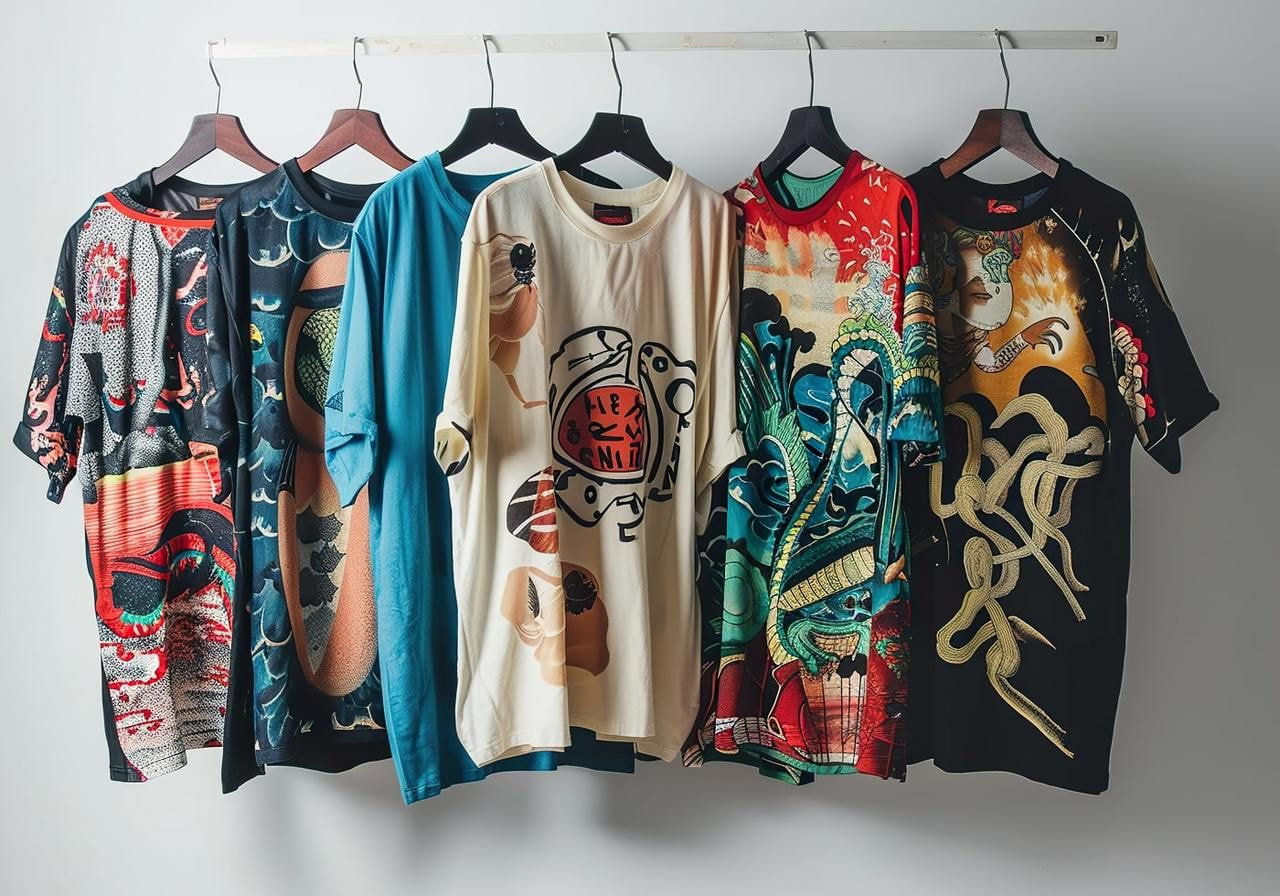4. Sublimation
Sublimation printer. Source: Adobe
Dye-sublimation printing was first developed in the 1950s by Noël de Plasse at the French company Lainière de Roubaix. Using heat to bond dye into polymer-coated surfaces, the technique made it possible to produce vibrant all-over prints and edge-to-edge designs.
Decades later, it became very important to POD because it works perfectly on polyester fabrics and polymer-coated goods like mugs. By using heat to bond dye into the surface itself, sublimation delivers vivid, durable, all-over prints.
Sublimation turned drinkware, phone cases, blankets, pillows, and sportswear like leggings, into POD staples in the 2000s and 2010s.
5. Direct-to-film (DTF)
The 2020s introduced another breakthrough – direct-to-film (DTF) printing. Instead of printing directly on fabric, the design is printed onto a special film, coated with adhesive powder, and heat-pressed onto the garment. The advantage is versatility, as DTF works on cotton, polyester, blends, and even tricky surfaces like nylon.
For POD, this opened new market trends, enabling sellers to offer items that DTG struggled with. Many fulfillment centers now run DTG and DTF side by side, routing orders to whichever printing method is best for the material.
6. Embroidery, engraving, and UV printing
Not all print-on-demand methods rely on ink. Previously available only for luxury goods, custom embroidery became widely available in the 2010s as fulfillment centers invested in fleets of computerized machines, making it possible to create one-off custom caps, polos, and jackets.

Laser engraving expanded customization into jewelry, tumblers, and wooden goods.
UV printing allows direct printing on rigid items like phone cases or acrylic plaques. Niche companies like Shapeways have even incorporated 3D printing, proving that Print on Demand can extend far beyond textiles.
Hardware innovations at a glance
The introduction of more advanced hardware made Print on Demand scalable. By the 2020s, new DTG and DTF printers could output hundreds of prints per hour, rivaling traditional methods in efficiency. Some models include robotics to load and unload garments, or cloud connectivity to integrate with eCommerce platforms.
-
Revolution (1996) – The first DTG prototype.
-
Kornit Storm (2005) – Integrated pretreat + CMYK + white, industrial-grade.
-
Brother GT-541 (2005) – Reliable entry into DTG.
-
Epson F2000 (2013) – Solved maintenance issues and boosted adoption.
Inks: The chemistry of change

Hardware and technology aren’t the only parts of printing that have evolved over the years. Ink, another key ingredient of a beautifully made print-on-demand product, has also undergone a few changes.
1. Plastisol dominance
In the mid-20th century, plastisol inks transformed screen printing. They were thick, vibrant, and didn’t dry on the screen, enabling efficient production and easier cleanup.
For decades, plastisol defined the look of printed t-shirts – bold, raised designs with durability. But plastisol contained PVC and phthalates, raising concerns about health and sustainability.
2. Water-based resurgence
By the 2000s, regulatory shifts and consumer demand pushed the industry back toward water-based inks.
These provided a softer feel, breathable prints, and a better environmental profile. Today, many POD providers embrace water-based inks to align with the values of minimizing waste and reducing the environmental impact of production.
3. DTG ink breakthroughs
Early DTG printers struggled because they couldn’t print on dark fabrics. The introduction of white ink in 2005 by DuPont changed that, making full-color prints possible on almost any garment.
Over time, DTG inks evolved into eco-certified, water-based pigment formulations that adhere to multiple fabrics and last through washes. Modern inks combine vibrancy, safety, and efficiency – a stark contrast to the traditional printing methods of the past.
Why technology mattered
The technological arc, from plastisol inks to eco-pigments, from screen presses to automated DTG systems, and broader advancements in garment printing, transformed Print on Demand from a small studio operation into an industrial powerhouse. Each advance reduced barriers – less initial investment, faster turnaround, broader material compatibility.
Technology didn’t just improve print quality – it redefined the economics of the POD industry. By combining automation, digital flexibility, and a distributed network of providers, Print on Demand became not only feasible but scalable, ready to serve millions of orders in an ever-changing world of fashion, retail, and personalization.
From t-shirts to… everything

For many people, when thinking of Print on Demand, the first image that comes to mind is usually a cotton t-shirt. And it makes sense – t-shirts were the earliest and most popular canvas for custom designs, easy to ship, and perfect for personal expression. However, the story of POD is also the story of steady expansion into almost every product category imaginable.
Staple beginnings
In the late 1990s and early 2000s, POD catalogs were slim. Platforms like CafePress and Spreadshirt focused on a handful of core items: t-shirts, mugs, posters, and stickers. These staples were simple to produce using DTG, heat transfers, or sublimation.
They also matched the needs of early niche markets, like fan clubs, political movements, or student groups that wanted a quick run of custom clothing and other items without large minimum orders.
Despite the limited range, these early products proved a powerful idea: people valued the ability to buy something that didn’t exist until they clicked “order.”
Expansion into lifestyle and niches
As technology advanced in the mid-2000s, print-on-demand catalogs diversified. Sublimation and large-format inkjets made it possible to print on textiles beyond tees – tote bags, mousepads, aprons, and calendars entered the mix. Wall art became a major category, too, as platforms like Redbubble and Society6 gave independent artists the chance to sell posters and canvases without managing inventory.

Custom tote bag. Source: Printful Catalog
The arrival of smartphones created an entirely new category. Around 2010, custom phone cases surged in popularity, usually printed via sublimation or UV flatbed printers. The shift reflected a broader trend – POD wasn’t only about apparel, but about helping people personalize their daily lives.
Fashion, home goods, and personalization
By the 2010s, POD embraced full-bleed sublimation (also called all-over-print or AOP) for polyester apparel. Leggings, yoga pants, and bomber jackets with all-over patterns became high-demand products. Sellers also introduced custom products for the home – pillows, blankets, curtains, even shower curtains – often decorated with customer photos or artwork.
Personalization surged in popularity during this era. Consumers increasingly wanted items tailored to them – not only artist-made designs, but products with a photo, a name, or a favorite color. What had once been limited to vinyl lettering in the early 2000s expanded into a much wider range of options.
The 2020s and hyper-niche products
The last decade saw POD stretch into areas that once seemed improbable. Pet lovers can now order custom bandanas, bowls, and beds. Jewelry can be engraved or UV-printed with personal messages. Some print-on-demand platforms even print fabric panels that are later assembled into sneakers.
For online stores, this explosion of variety is a competitive advantage. Sellers can test creative ideas quickly, adding new items to meet emerging markets or seasonal consumer preferences. Because there are no warehouses full of stock to clear, the risk of experimentation is low.
The sheer range of POD products today reflects how the business model has adapted to a global audience with highly diverse tastes, covering various products across fashion, home, and lifestyle.
Whether it’s a blanket for a gamer’s bedroom, a phone case featuring a viral meme, or a commemorative t-shirt for a local sports team, POD provides a way to fulfill the demand immediately and economically.
Why product expansion mattered
The shift from a handful of basics to hundreds of items opened up the business model for every type of seller.
Now, print-on-demand products include everything from jewelry to furniture, giving entrepreneurs an almost limitless toolkit. This growth has also pulled in bigger brands, who see POD as a way to test designs, reach potential customers, and avoid the pitfalls of excess inventory.
For many, the takeaway is simple: POD offers endless possibilities. The model adapts to consumer demand, whether that means nostalgic posters, personalized gifts, or experimental fashion. Each expansion has brought POD closer to being not just a clever workaround for small creators but a core pillar of modern retail.
POD and the creator economy

Print on Demand expanded beyond new product categories and changed who could participate in commerce. What once required warehouses, logistics contracts, and major retail partnerships became accessible to anyone with a design file and an internet connection.
This shift powered the rise of the creator economy.
Empowering independent creators
For artists and illustrators, POD services like Redbubble and Society6 provided a direct line to buyers. An independent creator could upload artwork, set a price, and have it printed on posters, mugs, or t-shirts. No stocking shelves, no shipping boxes.
This arrangement gave artists an outlet for creative ideas that might never attract traditional publishers or manufacturers.
The same was true for indie bands and political movements. Merchandise had long been a way to rally support, but POD eliminated the gamble of overordering. A musician could sell shirts with tour artwork, confident they’d never be left with unsold boxes. Activist groups could launch campaigns overnight, tailoring products to specific events or causes.
Influencers and microbrands
The 2010s added social media to the mix. As Instagram, YouTube, and later TikTok exploded, creators with loyal followings looked for ways to monetize their communities. POD became a natural fit.
By linking an online store to platforms like Shopify or Etsy, influencers could launch product lines without warehouses or sewing machines.
These microbrands often leaned on highly personal offerings, like a podcaster’s inside joke on a mug or a TikToker’s catchphrase on a hoodie.
For fans, buying was less about the object than about connecting with the creator. For creators, POD offered artistic freedom and branding control with little initial investment.
Culture and commerce intertwined
The creator economy turned cultural moments into commerce almost instantly. A viral meme could become a t-shirt within hours. A YouTube tutorial artist could branch into selling custom products. Small collectives of designers could test styles, gather feedback, and pivot quickly, thanks to POD’s lack of upfront costs.
This flexibility matched the fast-changing pace of online culture. When a phrase or image caught fire, sellers could transform it into merchandise almost overnight. POD absorbed the production risk, letting creators focus on engagement and storytelling – often the first step for those starting a small clothing business from home.
Why the creator economy mattered for POD
By empowering independent creators, Print on Demand became the go-to method for creating merchandise for niche fandoms, viral content, and grassroots movements.
At the same time, it attracted established brands. Fashion labels and entertainment companies began testing designs through POD before committing to huge volume orders, using the model to gauge interest from potential customers. In this way, creator-driven retail influenced larger players, showing that commerce could thrive outside the old rules.
